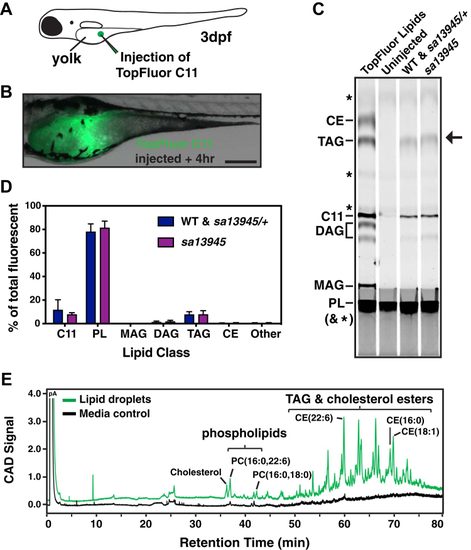
dgat2 mutant embryos are still capable of triacylglycerol synthesis in the YSL.A, TopFluor C11 fatty acid was mixed with canola oil and microinjected into the yolk mass of dgat2sa13945 mutants and siblings at 3 dpf. B, representative image of the TopFluor C11 signal in a dgat2sa13945 zebrafish yolk sac 4 h after injection; scale = 200 μm. C and D, lipids were extracted from TopFluor C11 injected embryos and separated by thin layer chromatography (20 pooled embryos per sample, wild-type and dgat2sa13945/+ embryos were combined). C, lipid classes were identified using TopFluor-labeled lipid standards. Arrow indicates TAG synthesized from TopFlour C11 in vivo. (CE: cholesterol ester, TAG: triacylglycerol, DAG: diacylglycerol, MAG: monoacylglycerol; PL: phospholipid; ∗ denote autofluorescent lipids in the fish lysate). D, the quantity of lipids in each class was quantified and expressed as a percent of total fluorescent lipids; N = 6 experiments, mean ± SD, Two-way ANOVA, not significantly different, p = 0.9929. Note, it appears that the TopFluor C11 is unable to be incorporated into cholesterol esters. E, large lipid droplets were manually dissected out of dgat2sa13945 larvae at 6 dpf (40–50 LDs from 30 – 40 larvae). Lipids in LDs or an equivalent volume of media surrounding dissected larvae were separated by multistep gradient HPLC and detected with a charged aerosol detector (CAD) in picoamperes (pA) as described in (75). The lipid droplet samples contain large quantities of triacylglycerols and cholesterol esters. Traces are representative of three independent experiments.
|

